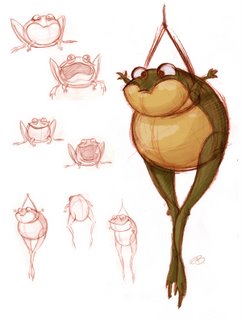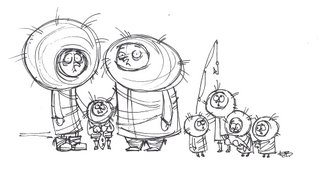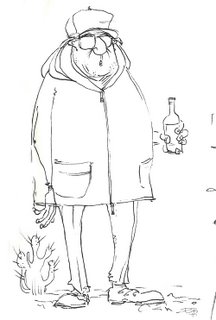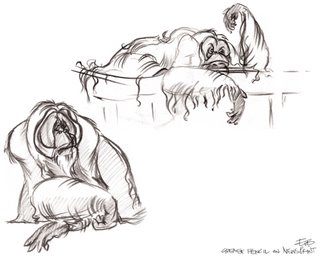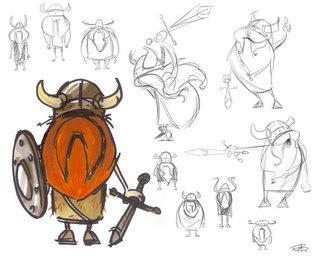ELAINE BOGAN INTERVIEW
Storyboard Artist at Dreamworks
Saturday, October 28, 2006
BROUGHT TO YOU BY THE CHARACTER DESIGN BLOGSPOT
IF YOU WOULD LIKE TO SEE MORE INTERVIEWS GO TO THE HOME PAGE BY CLICKING HERE
THE INTERVIEW

Tell me a little bit about yourself, about your life? Where did you go to school, and what classes did you study? What helped prepare you to become the artist that you are today?
Hello. I’m Elaine.
I have always been of the artistic persuasion. I’m Canadian born and raised and come from a house full of creativity. I grew up watching my Dad and older brother Rock Out! on the guitar, and Draw fantastic cartoons, so I was encouraged at a very young age. Fortunately I was able to pick up both of those hobbies, and turn at least one of them into a career. (don’t think I’ll ever be famous for playing songs on the ol’ Epiphone, but one can dream I guess). I majored in art all through High School. Who ever said you needed Math anyway?! Then I went to college for Photojournalism, and after that went on to study Classical Animation for three years at Sheridan College. When I graduated, I followed my brother David out to California (who had already been working at a studio in San Francisco for 9 years) to begin work for a Feature Animation Studio in L.A. (Dreamworks) as Storyboard Artist. I’ve been here for just over a year and a half now.
How do you go about designing, and what goes through your mind, from start to end?
Well, first, there’s the idea. When I have a particular image in mind, I first start by exploring different shapes, compositions, and moods in a character. And if need be, I do some real life observation. Usually, I start with very small thumbnail sketches, working with silhouettes and basic lines. I’m looking for whatever helps get across the emotion I have in mind. It all may sound very abstract, but I’m sure many people work the same way. I always find it helps to simplify a character or object down to its purist form and shape, and then work from that. A lot of the time however, I just leave the shape as it is.
I also find that working directly with ink on paper while exploring ideas for a character, forces you to be spontaneous, and confident with lines. It is quite the opposite of the technique mentioned above, but I find it always makes for an interesting character. Of course working with ink means that you can’t go back and erase, fix, and redraw, but that is one of the most important parts. By making mistakes, you can see instantly what it is that’s not working for that design, then with each drawing I get closer and closer to the design in mind. It is also a great exercise in becoming more confident and bold while you draw. There’s no going back.
What is a typical day for you, and who are the people you work with?
A typical day for me……hmmmmm. Well, it varies really. People running in and out of my office showing me their latest Air Guitar moves, Filling the new kids room with Balloons so they can’t get in to their computer (thanks Guys), Or simply staggering into the office in the morning, and getting right down to business, but only after a fair supply of Coffee courses through the veins. Mmmm. OH! And we have Zombie Tuesday, where we watch a zombie flick every lunch time. Needless to say, the studio environment is a pleasure to work in.
A typical week (or two) would mean being given a sequence from a script by my director and head of story. I brainstorm over it while drinking the studio dry of Coffee. Then I rough out the boards (in thumbnail size, then bigger) and pitch it to the rest of the story crew. After that, the sequence will probably go through a series of revisions and fixes to get to where the director had visualized it, and then into editorial to be added to the show reel or “Laika”. Lather, Rinse and Repeat.
What are some of the things that you have worked on?
In my third year of Classical Animation, I completed my 2 minute film. Being my first attempt at an animated film, I am quite reluctant to show it to anybody, Ha Ha. All part of the process I suppose. While making the film I really focused more on story and shot composition rather than the actual animation itself (it shows). I did this because I knew that Story was definitely the direction I wanted my career to take. Perhaps some day I’ll move on to other things, but so far, Story is where it’s at.
Since I Joined Dreamworks, I have worked on 2 feature films, and one half hour show all of which have not yet been released. (Hey, I’ve only been here a year and a half!)
Other than the work I do for the studio everyday, I have been doing some poster designs, and illustrations for a local theatres quarterly issued program, (The Steve Allen Theatre) which is a non-profit organization that supports local artists, musicians, and film makers.
Is there a design you have done that you are most proud of?
I don’t think so. I really consider most of my stuff as unfinished work, and it goes to the shelf waiting to be altered or polished up. I think this is sort of a self medicating, and encouraging thing that most artists have. To always be able to say, this isn’t great, or I’ll make sure to fix that in the next drawing. It’s a constant drive to improve, and be creative. Having the need to create is a wonderful feeling.
I think the thing I am most proud of is that I can still go home after work each day, and find time to relax with a sketchbook. The fact that I even want to pick up a pencil after a day of drawing, is a feat in itself. It helps being lucky enough to work in a profession that I love.
What projects have you done in the past, and what are you working on now? (if you can tell us)
I better dodge the bullet here, and say “no comment”. Contracts scare me.
Who do you think are the top artists out there?
Sigh, so many influential people to speak of. Being relatively new to the industry, I’ve had an amazing opportunity to meet and sometimes work with some of the most talented people I’ve ever seen. People I would definitely say you should check out are, Jakob Jensen, Pierre-Olivier Vincent, Graham Annable, Devin Crane, and Nicolas Marlet.
I take a lot of influence from several earlier artists like Eyvind Earle, Ward Kimball and all the old Warner Brothers designs. Although it may not show through in my work at all, I find whenever I look at some of that old stuff, it instantly inspires and generates a need to draw or paint. I also really enjoy Gris Grimly, Ragnar, and Quentin Blake (one of my all-time favorites!).
Could you talk about your process in coloring your art, as well as the types of tools or media that you use?
Currently, a lot of the work I do is on a Cintique. My roughs and concepts for real paintings are usually done digitally in Photoshop with the Cintique, and then I take the final draft to pencil and acrylic on board.
I use Ink and Marker a lot as well. I find it’s the medium I work best with, and it’s also incredibly quick and easy to handle. I like the aspect of having direct results.
When I paint or work digitally, I tend to work in layers…..many, many layers. I find it helps to envision where you want to go if you work layer by layer. It also leaves room for mistakes……many, many mistakes. I start by scanning a drawing in, then paint layers underneath the line.
What part of designing is most fun and easy, and what is most hard?
The most fun part about designing is you can pretty much do whatever you want. But this can also be the hardest part. So many options and different ways to express an idea can be daunting, and sometimes confusing, but the process of getting there is so creative and that’s what I enjoy the most.
What are some of the things that you do to keep yourself creative?
When at all possible, I go on road-trips to places I’ve never been before with the intention to draw, sketch and photograph anything I find interesting. New places, people, and things are always a great source for inspiration. I Visit the Zoo, draw people who don’t know I’m drawing them (Creeeepy), and try to do at least one drawing a day. It’s also helpful to experiment with different drawing surfaces. This I think forces more experimentation with a medium you are use to working with. For example working with pencil on paper, is much different than working with pencil on a block of wood…..or your Mothers dining room walls. Do it.
What is your most favorite subject to draw, And why?
My favorite subjects to draw, seem to be people and animals, does that narrow it down?
It must be because there is an unlimited number of ways a human or animal can be interpreted by using various shapes, proportions, and volume. And really…… what else is there?
What inspired you to become an Artist?
Being surrounded by Art and encouraged at a young age played a huge role. I’m always thankful that I had such encouraging parents. I also grew up watching all the great Disney and Warner Brothers shows and movies (the animators Cliché), which are permanently etched into my brain……I’ll never escape! Not that I’m complaining. (The Loony Tunes Soundtrack plays on loop in Elaine’s head) I was also quite attached to the Muppet Show. It’s one of the earliest influences I can remember. They just don’t make shows like that anymore.
What are some of the neat things you have learned from other artists that you have worked with or seen?
By far the most valuable piece of information I have learned as a Storyboard Artist, is “Always be ready to throw your work in the can and start again.” Don’t be precious with it.
When working in the story department, you may be working on a certain sequence for weeks, only to find that when you’re finally done, it has been cut from the movie. Bahh! It may be due to time restrictions, budget, or the scene may just not be necessary to carry the story along. I’ve learned I just have to suck it up and keep on truckin’. It probably sounds pretty crappy (and it is frustrating), but it’s just the way the job works. Again, it’s finding out what isn’t working for that scene or sequence that helps you to get to the finished product.
What are some of your favorite websites that you go to?
Some interesting and inspiring Blogs I have come across, and visit regularly are as follows:
http://blogarians.blogspot.com/ (a collaboration made by a group of Illustrators)
http://cartoonmodern.blogsome.com/ (Amid Amidi, the author of CARTOON MODERN)
http://justinpatrickparpan.blogspot.com/
http://animatedlife.blogspot.com/
http://www.joe-white.com/
http://www.elephantart.blogspot.com/
http://jakobhjensen.blogspot.com/
What wisdom could you give us, about being an Artist? Do you have any tips you could give?
It’s important to remember how lucky we are. We work in jobs that we love (hopefully) and get to draw, paint, and create (whatever the case may be) every single day. So enjoy it! That, I think, is the most valuable thing I could say here. Just think, you could be washing dishes, or cleaning the Llama pen in some creepy petting zoo instead. No offence to anyone who cleans the Llama pen, but they are a little creepy.
Now for the boring parts… Observation is important. Look at, and study the movement of everything. Making mistakes is one of the most important parts, don’t be precious with your work, and draw all the time!
If people would like to contact you, how would you like to be contacted?
www.theeelbog.blogspot.com
or
elainebogan@hotmail.com
I’d also like to thank the Blog Creator, Randall, for taking the time to create such a fantastic Blog. We Artists do tend to be tied to our desks for deadlines and/or other self destructive reasons. It’s nice to break out of the Ol’ Hermit Shell and see what’s going on in the outside world, and to get a chance to hear about and see fantastic work by fellow artists. And thanks for taking an interest in my work. It’s definitely a huge compliment being on the same site as such awesomely talented and accomplished artists.
Thanks Randall!
Finally, do you have any of your art work for sale (sketchbook, prints, or anything) for people that like your work can know where and when to buy it?
Nothing is officially for sale at this point, but I can always make prints.
Thank you for your time Elaine, and for the kind words.
Subscribe to:
Posts (Atom)

